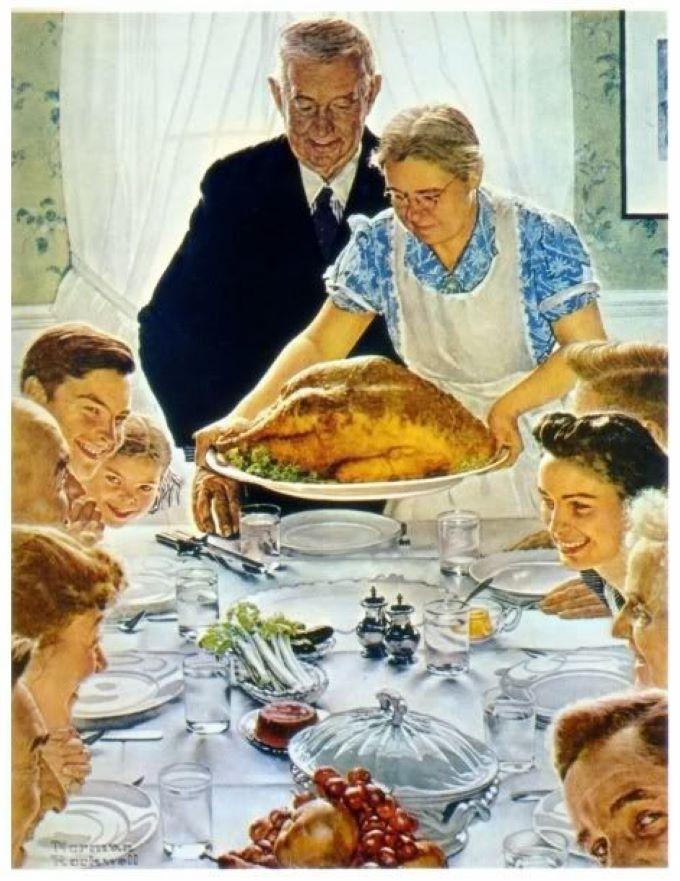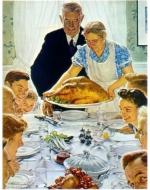Created by Mark Littke on Mon, 05/06/2024 - 03:10
Description:
This rather famous painting depicts a bigger middle-class family gathered around a clean, organized table for a plentiful Thanksgiving meal. The older couple in the middle of the artwork set down a sizeable turkey with attention and care, and the relatives and guests smile at each other as the dinner is soon to begin. Freedom From Want has been considered to be a simple yet profound, peaceful, and hope-giving for generations. This work has now “become an iconic representation for Americans of the Thanksgiving holiday and family holiday gatherings in general” (Raphel). This painting could certainly represent a liminal or transitional message about the middle-class and the American Dream. A message of this famous painting could namely be the death of a prosperous, trouble-free life for the average American and the rebirth of a corrupted American Dream of carelessness and frivolity. Freedom From Want could very well be reminding the viewer to be content with the hard-earned progress they have met and the modest, fulfilling pleasures it rewards. It warns those who do not appreciate the simple yet plentiful matters of life away from pursuing massive fame, haughtiness, and the disintegration of character that comes with this needless pursuit. This message is very similar to one of the many in F. Scott Fitzgerald’s The Great Gatsby.
In the novel, Jay Gatsby, a man from a modest rural background who moves to a nicer and generally grand property in Long Island, throws massive, expensive parties to impress his old flame, Daisy, to win back her heart. After failing to secure a life with her away from her wealthy and disloyal husband, Tom, Nick the narrator urges Gatsby to abandon his dream and accept reality. However, the reader soon sees Gatsby’s frustrated response: “But with every word [Daisy] was drawing further and further into herself, so he gave that up, and only the dead dream fought on as the afternoon slipped away, trying to touch what was no longer tangible” (Fitzgerald). Furthermore, Nick also shows Gatsby and the reader his contempt for careless and happy-go-lucky people of privilege and status like Tom and Daisy, who is even his own cousin: “ ‘They’re a rotten crowd,’ I shouted across the lawn. ‘You’re worth the whole damn bunch put together’ ” (Fitzgerald). Through the lenses of Fitzgerald’s novel and Rockwell’s painting, one can notice the theme arise that once the American Dream is realized for the average person, it dies; only power and jealousy can arise from this. One critical interpreter of The Great Gatsby also adds that a middle-class citizen like Gatsby would not rise to the next social class with the people already in it due to the inability of such a person to rise above their intellectual or aesthetic disposition (Betchel 118). It is thus fitting to conclude with this final thought: those escaping the intended rewards of honest work within the confines of the American Dream will end up destroyed or corrupted in wealth and hopeless clawing for contentment.
Works Cited
Bechtel, Dianne E. “Jay Gatsby, Failed Intellectual: F. Scott Fitzgerald’s Trope for Social Stratification.” The F. Scott Fitzgerald Review, vol. 15, no. 1, 2017, pp. 117–29. JSTOR, https://doi.org/10.5325/fscotfitzrevi.15.1.0117.
Fitzgerald, Francis Scott Key. “The Great Gatsby.” Gutenberg.Org, 17 Jan. 2021, www.gutenberg.org/cache/epub/64317/pg64317-images.html.
Raphel, Stephanie. “Smithsonian Learning Lab Resource: Freedom from Want.” Smithsonian Learning Lab, Smithsonian Office of Educational Technology, 26 Jul. 2020, https://learninglab.si.edu/q/ll-c/8EZIqu0dTeOikPV4#r/854901
Copyright:
Associated Place(s)
Part of Group:
Featured in Exhibit:
Artist:
- Norman Rockwell


